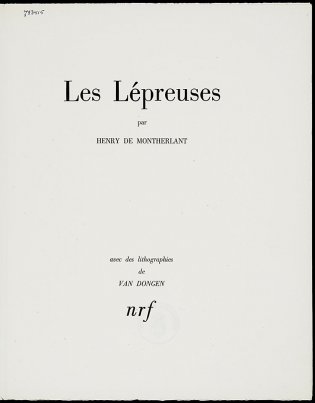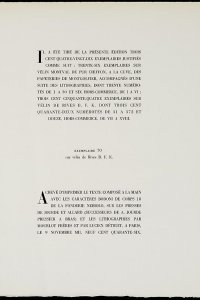Les lépreuses
Year: 1947
Author: Henry de Montherlant (1896 - 1972)
Artist: Kees van Dongen (1877 - 1968)
Publisher: NRF
Characteristic illustrations
Les lepreuses (1939), the fourth and final part of the controversial cycle of novels Les jeunes filles by Henry de Montherlant, was published in 1947 by NRF/Gallimard in a limited edition, illustrated by the artist. The lithographs for this work were printed in the studio of Fernand Mourlot (1895-1988), just like Van Dongen's other books. Mourlot printed the work of nearly all the great artists in Paris, making his name as executor and promoter of lithography. In Mourlot's studio, Van Dongen drew and painted the various colour states for his lithographs. The result for Les lepreuses could be called 'typical' Van Dongen. The 26 illustrations (cover included) are colourful images of flowers, cats, dogs, naked women, and some beach and restaurant scenes.
Bibliographical description
Description: Les lépreuses / par Henry de Montherlant ; avec des lithogr. de Van Dongen. - Paris : N.R.F., 1947. - [260] p. : ill. ; 34 cm
1e uitgave: 1939
Printer: Jourde en Allard (Parijs) Mourlot (Parijs) Lucien Détruit (Paris)
Edition: 390 copies
This copy: Number 70 of 354 on Rives B.F.K.
Typeface: Bodoni
Bibliography: Bénézit 4-667 ; Monod 8374 ; Prout II-470-03
Shelfmark: KW Koopm A 399
References
- Paul van Capelleveen, Sophie Ham, Jordy Joubij, Voices and visions. The Koopman Collection and the Art of the French Book. The Hague, Koninklijke Bibliotheek, National Library of the Netherlands; Zwolle, Waanders, 2009
- Paul van Capelleveen, Sophie Ham, Jordy Joubij, Voix et visions. La Collection Koopman et l'Art du Livre français. La Haye, Koninklijke Bibliotheek, Bibliothèque nationale des Pays-Bas; Zwolle, Waanders, 2009
- Louis Haumeil, Van Dongen, l'homme et l'artiste, la vie et l'oeuvre. Genève, Cailler, 1967
- Jan Juffermans, Kees van Dongen: Het grafische werk. Zwolle, Waanders, 2002
- Fernand Mourlot, Gravés dans ma mémoire. Paris, Opera Mundi, 1979
- Pierre Sipriot, Montherlant sans masque: 'écris avec ton sang' 1932-1972, T. II. Paris, Laffont, 1990


![Pagina [9] met litho door Kees van Dongen](/sites/default/files/styles/galerie/public/images/les-lepreuses-p9.jpg?h=f204d1a7&itok=UT7kFXTm)


